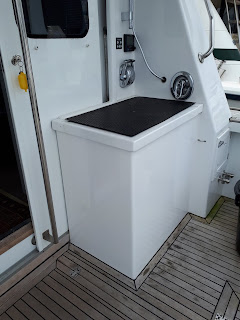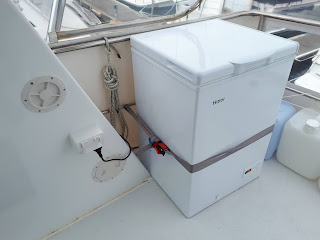Our
last post prompted a question about refrigeration from a reader in
France, so here’s a few comments on that subject.
When
we were in the Med meeting
fellow cruisers (the vast majority of whom were aboard sailing
yachts) one of the most common discussion threads was the difficulty
of keeping house battery banks charged. In virtually all these cases the
cruisers with these issues had battery powered refrigeration. Modern
technology has certainly
reduced
refrigeration’s power requirements, but there’s no doubt it’s
still
likely to be your biggest current draw.
Boat
refrigeration is powered in one of the following ways:
1.
An engine driven compressor – this is very efficient, but only
operates when your engine is running. Usually the same compressor powers both a refrigerator and freezer. There can be issues with
controlling temperature as in some installations items in the refrigerator section will freeze if
the system is run too long.
2.
DC power from battery bank – is efficient but results in heavy current draws,
3.
AC power from generator and/or inverter. Very efficient but note
that quite a large inverter is needed due to refrigeration’s high
start up current draw.
4.
A combination of above – is ideal.
I
haven’t included LPG
powered refrigeration as with
a pilot light it’s
regarded as
unsafe for
marine applications.
Whatever
system is used stainless steel lined appliances seem to work better
than plastic lined ones and those with built-in brine plates make
them even more effective. A
big advantage of systems
2 and 3 is
they invariably
allow for continuous operation on shore power using a battery charger
in the case of DC or an inverter generally passing current directly
through to
the appliance in
the case of AC.
On
our last boat we used AC power from our genset or shore power and
found that worked extremely well.
Depending
on the ambient temperature and the number of people aboard (more
people = more “drain” on refrigeration) we
ran the genset for about 60-90
mins morning and evening. During that time we’d also charge the
batteries and often do some washing, heat
the hot water tank
and
use the water maker.
Rapport
has
an Engel
refrigerator (with
a small freezer section) in
the galley powered both by AC and 24V DC plus a combination
refrigerator / freezer powered by an engine driven compressor. The
latter
works fine if you are cruising every day, but if anchored or
staying in a marina for several days we had no freezer without
running an engine for a couple of hours a day, so
we decided to install an AC powered freezer on the flybridge. On
boats we prefer chest to front opening freezers. The latter are more
convenient to use but in our view not as effective. Where possible
and mainly due to price we believe it’s best to use standard
household appliances so we chose a 220V
powered Haier
HCF101 chest
freezer with
101 litres capacity costing
only $439 (about 242
Euros). We
installed a double AC power point in the flybridge and the freezer is protected
from weather by the flybridge’s vinyl screens. When
on shore power our inverter passes incoming AC current directly
through to connected AC appliances. Underway with
the engines charging the batteries
we use the 4.1Kw
inverter to
provide AC power and at anchor we also
use the inverter
while using the genset to periodically boost the batteries. We
find the refrigerator and freezer combined draw less than 5 amps.
Since our
cooking is electric we need to run the genset during the evening in
any case and
can then also heat our hot water and sometimes use our water maker.
This is the compressor driven chest freezer located in the cockpit
The compressor driven refrigerator is in the saloon (the freezer is on the other side of the bulkhead)
A
few tips we’ve found useful:
1.
Pack your
refrigerator and freezer as full as possible to make them operate
more efficiently. Use different sized bottles of water to use up any
spare
space.
2.
Turn them OFF or down during the night to conserve battery power. When not being
opened they lose little temperature overnight.
3. Use your thermostat – when you have charging power available turn the thermostat down (ie colder) so the appliance runs more or less continuously and when you have no power turn it up so it runs less.
4.
Use your freezer to freeze bottles of water. Each day or two put some
in your refrigerator to help keep its temperature down. As the water
bottles thaw use them for cold drinking water and
replace.
5.
If you have more food and drink to keep cool than your refrigeration
capacity allows
use your
freezer to freeze a few bottles of water and freezer pads, then
store additional supplies in an Esky, changing the bottles over every
couple of days. This is particularly good for bulky vegetables and
salads as well as wine and soft drinks (beer needs to be colder!)
6.
Cans of drinks store more easily, are easier to dispose of and seem to
get colder than glass or plastic bottles.



